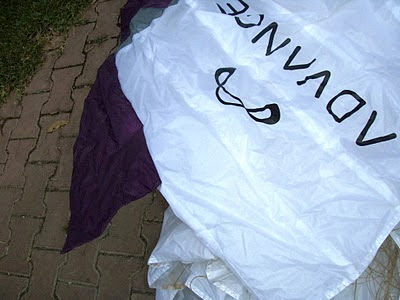The NIVIUK PEAK 1 was a revelation in 2007,by its climb capacity and its glide at speed was unbeatable at the time.But i didn't like its handling,and it was slow at trim.It was lacking of character and felt that the glider passed the EN-D tests being too "tied up"...
But having flown the ARTIC 2 ,and liked it a lot !!! i knew that the designer OLIVIER NEF is full of surprises...So i waited a long time for the birth of the PEAK 2.
Quality: It is very fruitful and great that a company listens to the pilots !!
The attachment points are now impeccable.With the smallest details,the glider is made.
A usb comes with the glider but i hoped to see the Peak 2 on it...:-(
The A's are attached to the B's and have a 10 cm slack ! Have to be delicate in launching.
In the air:
Today we flew in a site that is not supposed to be flown by north wind because it will be turbulent and not pleasant.
But we did go up anyway and it was windy from the north ! as predicted.
But we did go up anyway and it was windy from the north ! as predicted.
My friend flew his Venus 2 M @ 102 and and i was on the Peak 2 24 @ 95 all up.
In the air it was super turbulent,as my friend describe it later and not pleasant at all.As he knows very well his Venus 2 he gave me later a 9/10 grade of turbulent conditions.
What about me on the Peak 2 ?
It was my third flight on the Peak 2 and i felt also that the conditions were sometimes intolerable.
But the Peak 2 never felt very bad.It was sometimes keeping me busy, but still "manageable" . (For an EN-D pilot ) !
Overall ,the glider is smooth and comfortable in the air.
Coring those thermals was easy and "smooth" ! Crisp brakes maybe because of the plastic inserts on the trailing edge !!
Climb rate in strong conditions:
The Peak 2 @ 92 has a good climb rate. Loaded at 100 it suffers a bit vs the GTO loaded at 102 kg.
But in a homogeneous thermal, it climbs nearly the same.
Glide :
The glide at trim is also very good but pushing the soft accelerator gives an impressive glide !!It has the same glide as the omega 8 but it is faster .
Climb rate in weak conditions:
The glider does not like to be heavily loaded and in very weak conditions it is best to fly it at 92. Above that weight and at 98 and above it will suffer in the very weak stuff.It is very different than the Peak 1 ,which was very efficient in those conditions.
Now the only point i have to get used to,is the Big ears...Yes it is unstable even accelerated.And 5/10 times a line get tangled. I always had to pull the stabilo line hard to loose it. Sometimes if i let each one at a time slowly the line could not be tangled...!
I have tried one ear with a more pull on one side .It is in this configuration a little less unstable.Now the second one also ...did not work without being a little unstable.The harness when pulling big ears becomes very roll responsive to a certain degree.
It could be a plus for weight shifting ! But the ears will take a little time to get used to pull them in a proper way.
If i let the ears fast the glider opens with a "boom" too much energy.May be this is why the line got tangled.When i let it slowly it will open much better.
Conclusion:
The Peak 2 looks more accessible than the Peak 1 with very nice and smooth handling .The good thing is that you will not feel like you are flying a de-tuned comp glider with too much restrains to pass the EN-D tests ...It is a completely different glider than its successor !! ...Trim speed around 40-41 km/h .Touch the bar ,and prepare yourself for "light speed mode " ;-)
This glider is a "floater" when lightly loaded ,and a great head wind distance swallower if loaded at 98 and beyond !
http://www.youtube.com/watch?v=0HIyFfNabbc
Peak 2 VS Omega 8
http://www.youtube.com/watch?v=578ZIj_HDTo
Another video from the same flight ,taken from different cam,
http://www.youtube.com/watch?v=iYAi55Pq6kk
:-)
















































